 To make a sensible comparison of one year’s national income generated from the production of goods and services with another we need to take inflation into account. Changes in inflation-adjusted GDP represent changes in the volume of production of a country’s goods and services: in other words, the real value of goods and services. We revisit the blog written back in April 2019, prior the pandemic, to show how changes in real GDP evidence what we may refer to as the twin characteristics of economic growth: positive long-term growth but with fluctuating short-term rates of growth.
To make a sensible comparison of one year’s national income generated from the production of goods and services with another we need to take inflation into account. Changes in inflation-adjusted GDP represent changes in the volume of production of a country’s goods and services: in other words, the real value of goods and services. We revisit the blog written back in April 2019, prior the pandemic, to show how changes in real GDP evidence what we may refer to as the twin characteristics of economic growth: positive long-term growth but with fluctuating short-term rates of growth.
Real and nominal GDP
The nominal or current-price estimate for UK Gross Domestic Product in 2020 is £2.156 trillion. It is the value of output produced within the country in 2020. This was a fall of 4.4 per cent on the £2.255 trillion recorded in 2019. These values make no adjustment for inflation and therefore reflect the prices of output that were prevailing at the time.
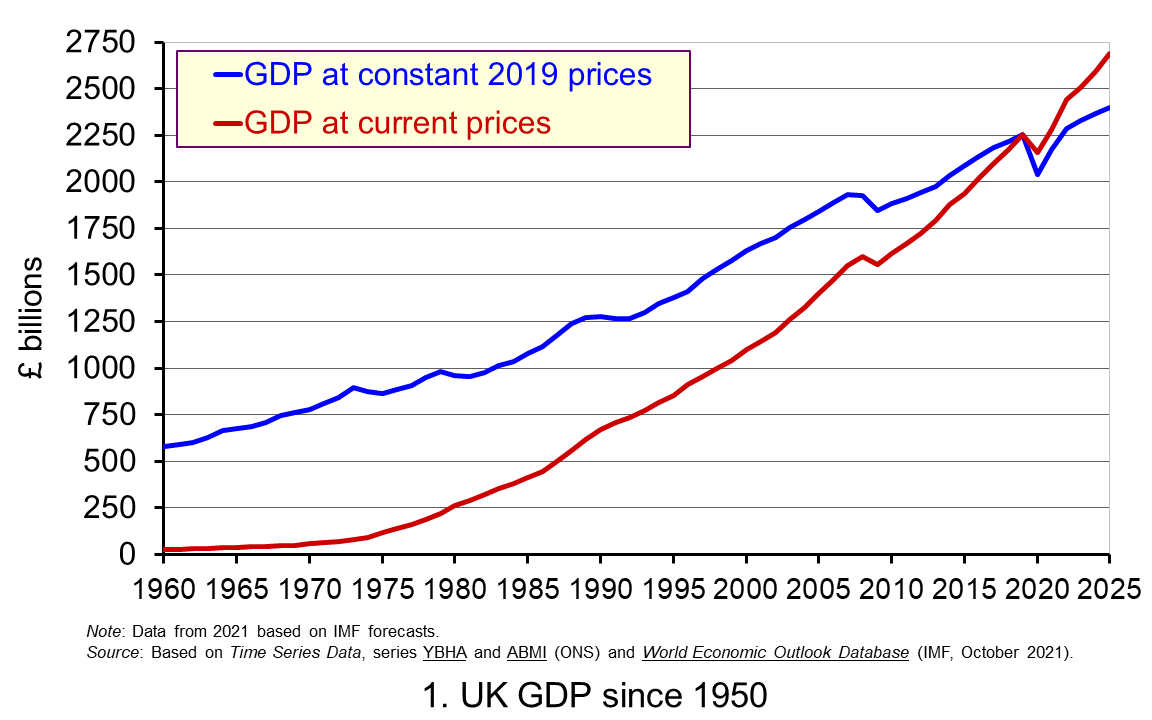 Chart 1 shows current-price estimates of GDP from 1950 when the value of GDP was estimated at £12.7 billion. The increase to £2.156 trillion in 2020 amounts to a proportionate increase of almost 170 times, a figure that rises to 211 times if we compare the 1950 value with the latest IMF estimate for 2025 of £2.689 trillion. However, if we want to make a more meaningful comparison of the country’s national income by looking at the longer-term increase in the volume of production, we need to adjust for inflation. (Click here to download a PowerPoint copy of the chart.)
Chart 1 shows current-price estimates of GDP from 1950 when the value of GDP was estimated at £12.7 billion. The increase to £2.156 trillion in 2020 amounts to a proportionate increase of almost 170 times, a figure that rises to 211 times if we compare the 1950 value with the latest IMF estimate for 2025 of £2.689 trillion. However, if we want to make a more meaningful comparison of the country’s national income by looking at the longer-term increase in the volume of production, we need to adjust for inflation. (Click here to download a PowerPoint copy of the chart.)
Long-term growth in real GDP
If we measure GDP at constant prices, we eliminate the effect of inflation. To construct a constant-price series for GDP a process known as chain-linking is used. This involves taking consecutive pairs of years, e.g. 2020 and 2021, and estimating what GDP would be in the most recent year (in this case, 2021) if the previous year’s prices (i.e. 2020) had continued to prevail. By calculating the percentage change from the previous year’s GDP value we have an estimate of the volume change. If this is repeated for other pairs of years, we have a series of percentage changes that capture the volume changes from year-to-year. Finally, a reference year is chosen and the percentage changes are applied backwards and forwards from the nominal GDP value for the reference year – the volume changes forwards and backwards from this point.
In effect, a real GDP series creates a quantity measure in monetary terms. Chart 1 shows GDP at constant 2019 prices (real GDP) alongside GDP at current prices (nominal GDP). Consider first the real GDP numbers for 1950 and 2020. GDP in 1950 at 2019 prices was £410.1 billion. This is higher than the current-price value because prices in 2019 (the reference year) were higher than those in 1950. Meanwhile, GDP in 2020 when measured at 2019 prices was £2.037 trillion. This constant-price value is smaller than the corresponding current-price value because prices in 2019 where lower than those in 2020.
Between 1950 and 2020 real GDP increased 5.0 times. If we extend the period to 2025, again using the latest IMF estimates, the increase is 5.9 times. Because we have removed the effect of inflation, the real growth figure is much lower than the nominal growth figure. Crucially, what we are left with is an indicator of the long-term growth in the volume of the economy’s output and hence an increase in national income that is backed up by an increase in production. Whereas nominal growth rates are affected both by changes in volumes and prices, real growth rates reflect only changes in volumes.
The upward trajectory observed in constant-price GDP is therefore evidence of positive longer-term growth. This is one of the twin characteristics of growth.
Short-term fluctuations in the growth of real GDP
The second characteristic is fluctuations in the rate of growth from period to period. We can see this second characteristic more clearly by plotting the percentage change in real GDP from year to year.
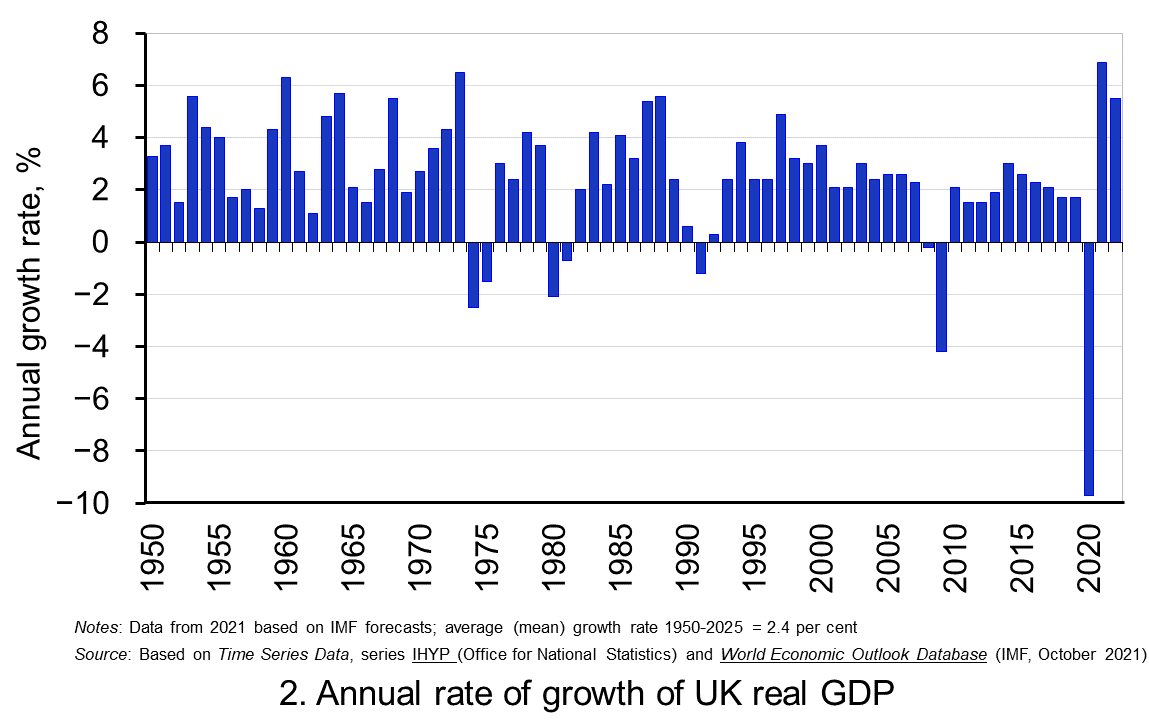 Chart 2 shows the annual rate of growth in real GDP each year since 1950. From it, we see the inherent instability that is a key characteristic of the macroeconomic environment. This instability is, of course, mirrored in the output path of real GDP in Chart 1, but the annual rates of growth show the instability more clearly. We can readily see the impact on national output of the global financial crisis and the global health emergency.
Chart 2 shows the annual rate of growth in real GDP each year since 1950. From it, we see the inherent instability that is a key characteristic of the macroeconomic environment. This instability is, of course, mirrored in the output path of real GDP in Chart 1, but the annual rates of growth show the instability more clearly. We can readily see the impact on national output of the global financial crisis and the global health emergency.
In 2009, constant-price GDP in the UK fell by 4.25 per cent. Then, in 2020, constant-price GDP and, hence, the volume of national output fell by 9.7 per cent, as compared to a 4.4 per cent fall in current-price GDP that we identified earlier. These global, ‘once-in-a-generation’ shocks are stark examples of the instability that characterises economies and which generate the ‘ups and downs’ in an economy’s output path, known more simply as ‘the business cycle’. (Click here to download a PowerPoint copy of the chart.)
Determinants of long-and short-term growth
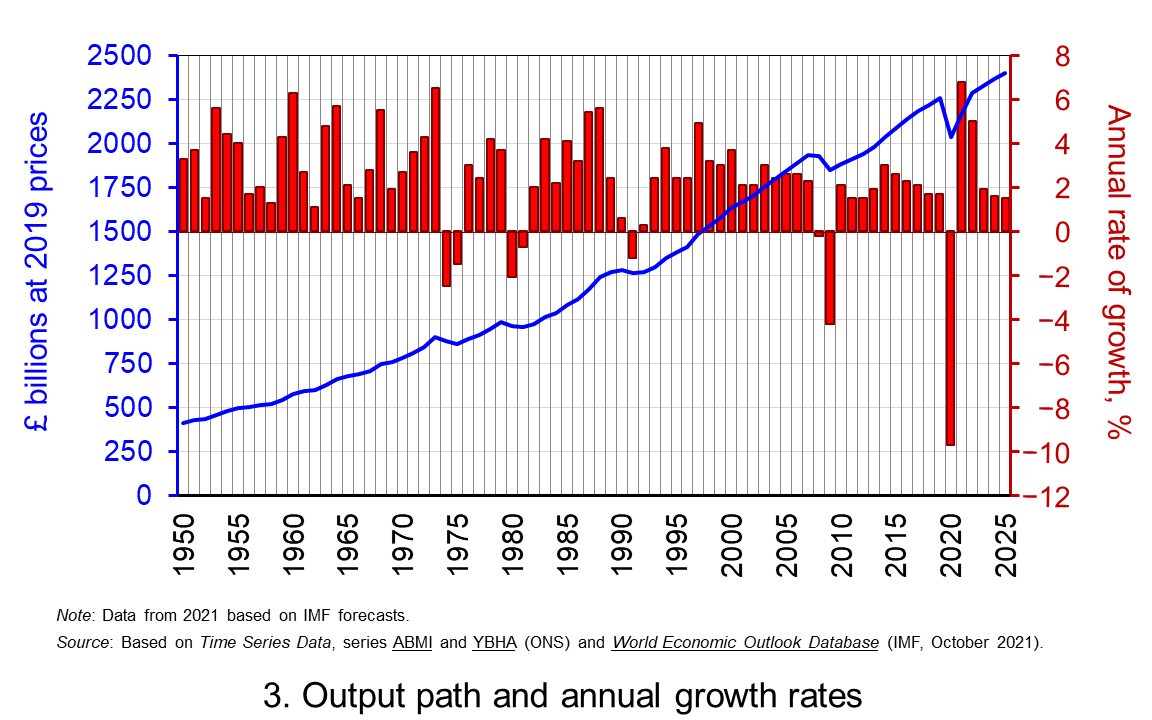 The twin characteristics of growth can be seen simultaneously by combining the output path captured by the levels of real GDP with the annual rates of growth. This is shown in Chart 3. The longer-term growth seen in the economy’s output path is generally argued to be driven by the quantity and quality of the economy’s resources, and their effectiveness when combined in production. In other words, it is the supply-side that determines the trajectory of the output path over the longer term. (Click here to download a PowerPoint copy of the chart.)
The twin characteristics of growth can be seen simultaneously by combining the output path captured by the levels of real GDP with the annual rates of growth. This is shown in Chart 3. The longer-term growth seen in the economy’s output path is generally argued to be driven by the quantity and quality of the economy’s resources, and their effectiveness when combined in production. In other words, it is the supply-side that determines the trajectory of the output path over the longer term. (Click here to download a PowerPoint copy of the chart.)
However, the fluctuations we observe in short-term growth rates tend to reflect impulses that affect the ability and or willingness of producers to supply (supply-side shocks) and purchasers to consume (demand-side shocks). These impulses are then propagated and their effects, therefore, transmitted through the economy.
Effects of the pandemic
The pandemic is unusual in that the health intervention measures employed by governments around the world resulted in simultaneous negative aggregate demand and aggregate supply shocks. Economists were particularly concerned that the magnitude of these impulses and their propagation had the potential to generate scarring effects and hence negative hysteresis effects. The concern was that these would affect the level of real GDP in the medium-to-longer term and, hence, the vertical position of the output path, as well as the longer-term rate of growth and, hence, the steepness of the output path.
The extent of these scarring effects continues to be debated. The ability of businesses and workers to adapt their practices, the extraordinary fiscal and monetary measures that were undertaken in many countries, and the roll-out of vaccines programmes, especially in advanced economies, have helped to mitigate some of these effects. For example, the latest IMF forecasts for output in the USA in 2024 are over 2 per cent higher than those made back in October 2019.
Scarring effects are, however, thought to be an ongoing issue in the UK. The IMF is now expecting output in the UK to be nearly 3 per cent lower than it originally forecast back in October 2019. Therefore, whilst UK output is set to recover, scarring effects on the UK economy will mean that the output path traced out by real GDP will remain, at least in the medium term, vertically lower than was expected before the pandemic.
Data and Reports
Articles
Questions
- What do you understand by the term ‘macroeconomic environment’? What data could be used to describe the macroeconomic environment?
- When a country experiences positive rates of inflation, which is higher: nominal economic growth or real economic growth?
- Does an increase in nominal GDP mean a country’s production has increased? Explain your answer.
- Does a decrease in nominal GDP mean a country’s production has decreased? Explain your answer.
- Why does a change in the growth of real GDP allow us to focus on what has happened to the volume of production?
- What does the concept of the ‘business cycle’ have to do with real rates of economic growth?
- When would falls in real GDP be classified as a recession?
- Distinguish between the concepts of ‘short-term growth rates’ and ‘longer-term growth’.
- What do you understand by the term hysteresis? By what means can hysteresis effects be generated?
- Discuss the proposition that the pandemic could have a positive effect on longer-term growth rates because of the ways that people and business have had to adapt.
 Back in June, we examined the macroeconomic forecasts of the three agencies, the IMF, the OECD and the European Commission, all of which publish forecasts every six months. The IMF has recently published its latest World Economic Outlook (WEO) and its accompanying database. Unlike the April WEO, which, given the huge uncertainty surrounding the pandemic and its economic effects, only forecast as far as 2021, the latest version forecasts as far ahead as 2025.
Back in June, we examined the macroeconomic forecasts of the three agencies, the IMF, the OECD and the European Commission, all of which publish forecasts every six months. The IMF has recently published its latest World Economic Outlook (WEO) and its accompanying database. Unlike the April WEO, which, given the huge uncertainty surrounding the pandemic and its economic effects, only forecast as far as 2021, the latest version forecasts as far ahead as 2025.
 In essence the picture is similar to that painted in April. The IMF predicts a large-scale fall in GDP and rise in unemployment, government borrowing and government debt for 2020 (compared with 2019) across virtually all countries.
In essence the picture is similar to that painted in April. The IMF predicts a large-scale fall in GDP and rise in unemployment, government borrowing and government debt for 2020 (compared with 2019) across virtually all countries.
World real GDP is predicted to fall by 4.4%. For many countries the fall will be much steeper. In the UK, GDP is predicted to fall by 9.8%; in the eurozone, by 8.3%; in India, by 10.3%; in Italy, by 10.8%; in Spain, by 12.8%. 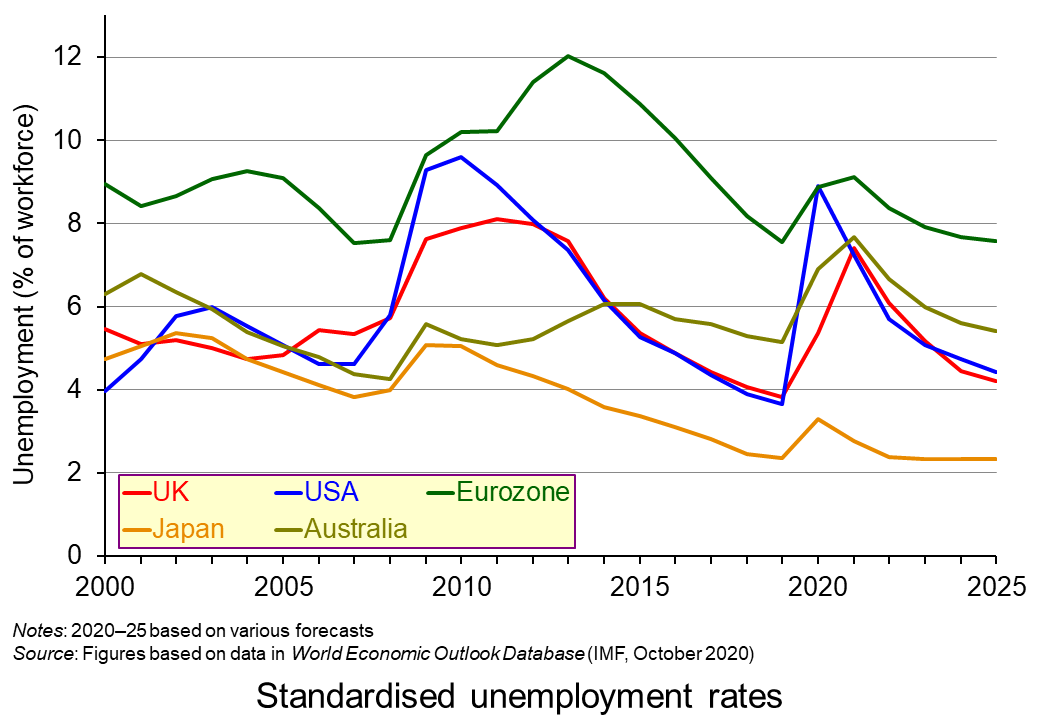 There will then be somewhat of a ‘bounce back’ in GDP in 2021, but not to the levels of 2019. World real GDP is predicted to rise by 5.2% in 2021. (Click here for a PowerPoint of the growth chart.)
There will then be somewhat of a ‘bounce back’ in GDP in 2021, but not to the levels of 2019. World real GDP is predicted to rise by 5.2% in 2021. (Click here for a PowerPoint of the growth chart.)
Unemployment will peak in some countries in 2020 and in others in 2021 depending on the speed of recovery from recession and the mobility of labour. (Click here for a PowerPoint of the unemployment chart.)
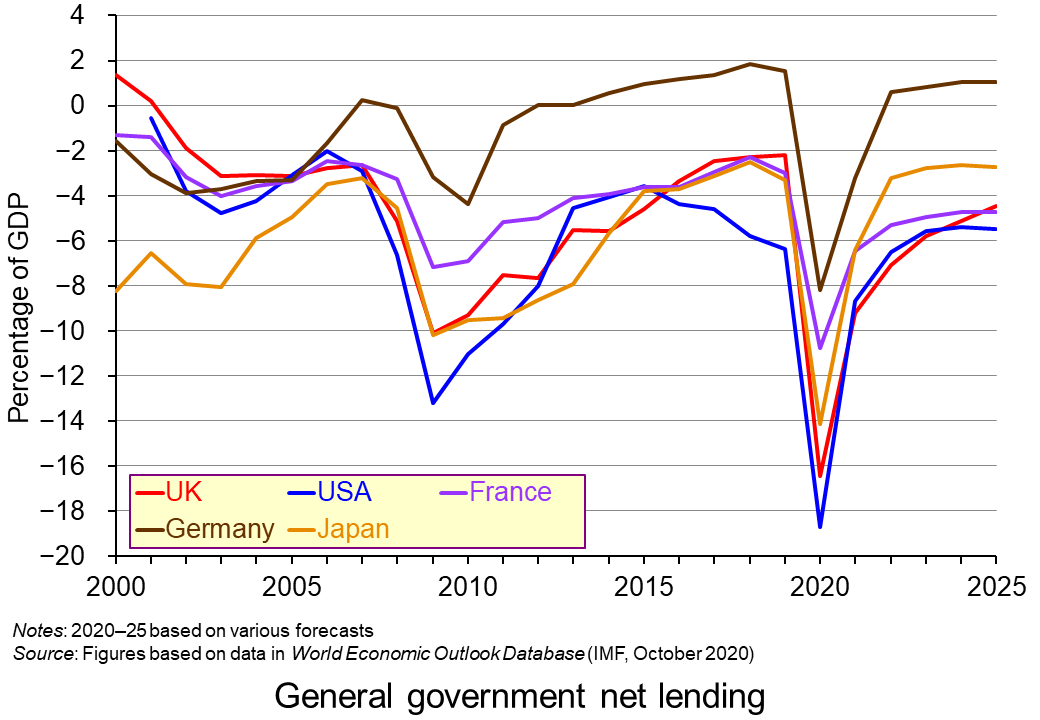 Inflation is set to fall from already low levels. Several countries are expected to see falling prices.
Inflation is set to fall from already low levels. Several countries are expected to see falling prices.
Government deficits (negative net lending) will be sharply higher in 2020 as a result of government measures to support workers and firms affected by lockdowns and falling demand. Governments will also receive reduced tax revenues. (Click here for a PowerPoint of the general government net lending chart.)
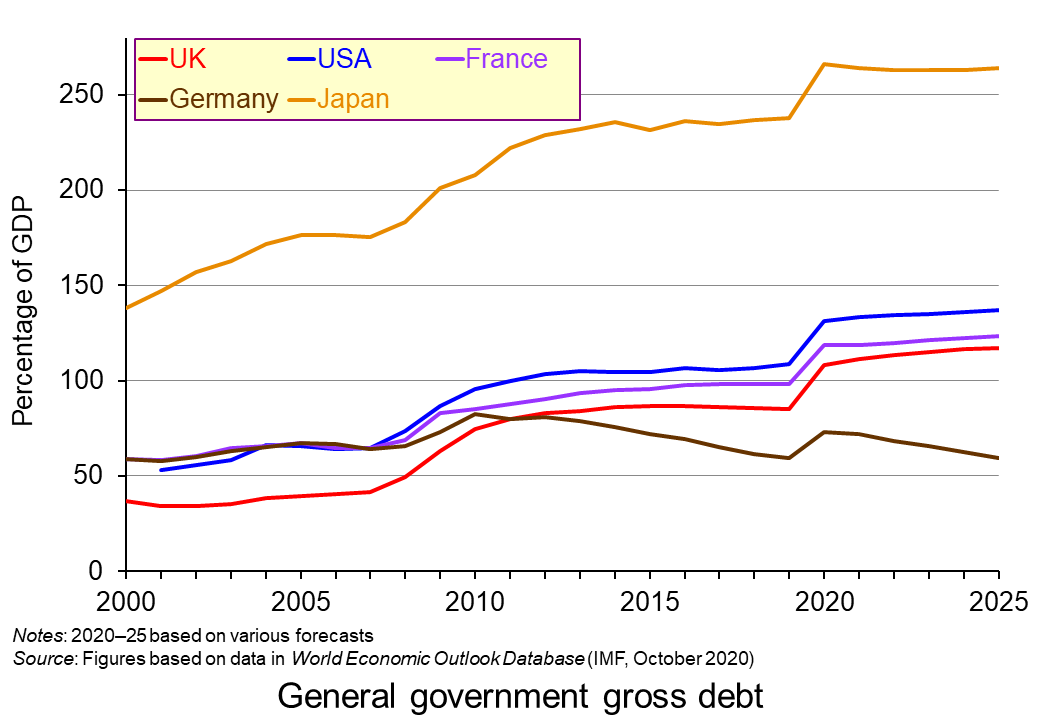 Government debt will consequently rise more rapidly. Deficits are predicted to fall in 2021 as economies recover and hence the rise in debt will slow down or in some cases, such as Germany, even fall. (Click here for a PowerPoint of the general government gross debt chart.)
Government debt will consequently rise more rapidly. Deficits are predicted to fall in 2021 as economies recover and hence the rise in debt will slow down or in some cases, such as Germany, even fall. (Click here for a PowerPoint of the general government gross debt chart.)
After the rebound in 2021, global growth is then expected to slow to around 3.5% by 2025. This compares with an average of 3.8% from 2000 to 2019. Growth of advanced economies is expected to slow to 1.7%. It averaged 1.9% from 2000 to 2019. For emerging market and developing countries it is expected to slow to 4.7% from an average of 5.7% from 2000 to 2019. These figures suggest some longer-term scarring effects from the pandemic.
Uncertainties
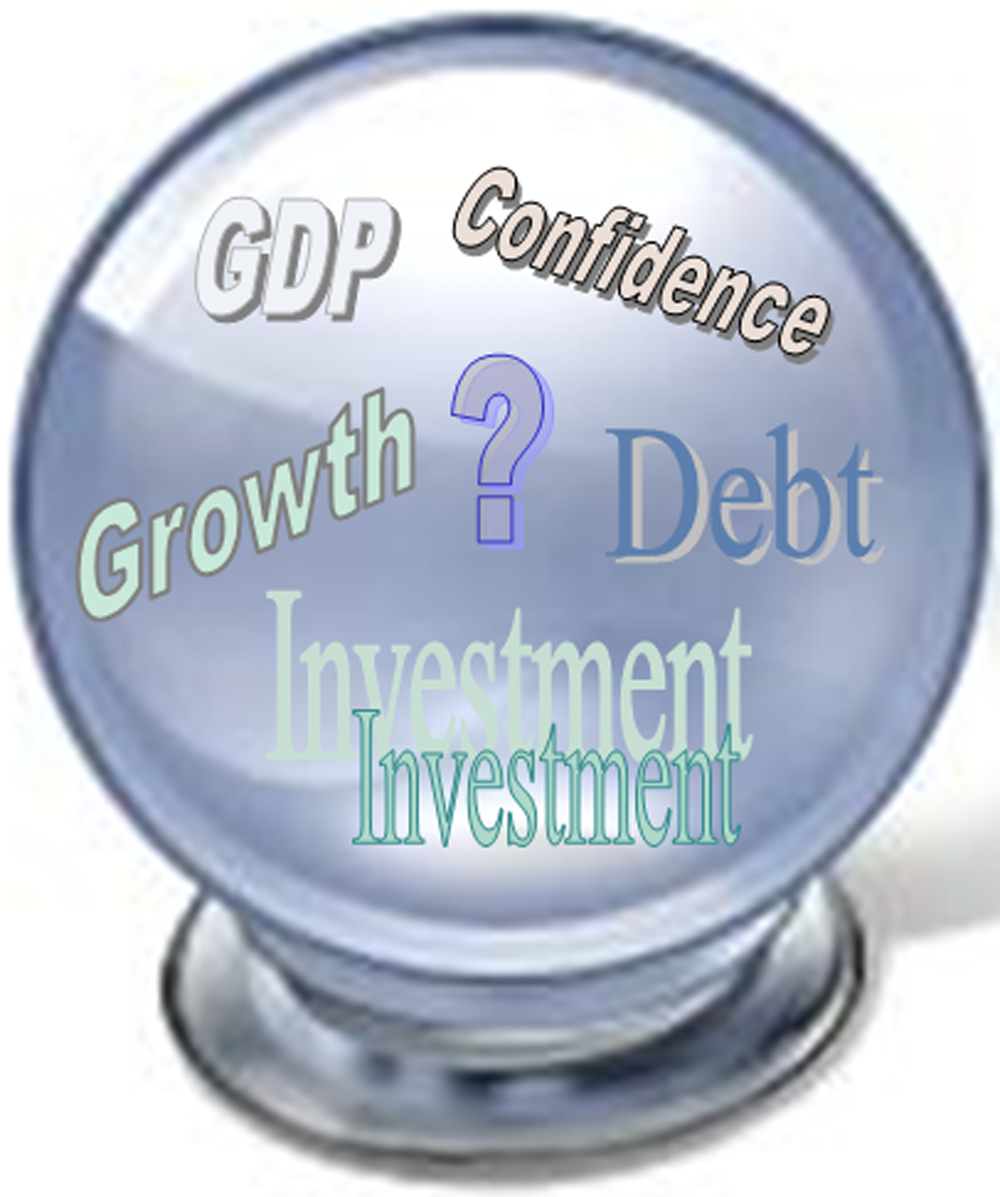 In the short term, the greatest uncertainty concerns the extent of the second wave, the measures put in place to contain the spread of the virus and the compensation provided by governments to businesses and workers. The WEO report was prepared when the second wave was only just beginning. It could well be that countries will experience a deeper recession in 2000 and into 2021 than predicted by the IMF.
In the short term, the greatest uncertainty concerns the extent of the second wave, the measures put in place to contain the spread of the virus and the compensation provided by governments to businesses and workers. The WEO report was prepared when the second wave was only just beginning. It could well be that countries will experience a deeper recession in 2000 and into 2021 than predicted by the IMF.
This is recognised in the forecast.
The persistence of the shock remains uncertain and relates to factors inherently difficult to predict, including the path of the pandemic, the adjustment costs it imposes on the economy, the effectiveness of the economic policy response, and the evolution of financial sentiment.
With some businesses forced to close, others operating at reduced capacity because of social distancing in the workplace and with dampened demand, many countries may find output falling again. The extent will to a large extent depend on the levels of government support.
In the medium term, it is assumed that there will be a vaccine and that economies can begin functioning normally again. However, the report does recognise the long-term scarring effects caused by low levels of investment, deskilling and demotivation of the parts of the workforce, loss of capacity and disruptions to various supply chains.
The deep downturn this year will damage supply potential to varying degrees across economies. The impact will depend on various factors … including the extent of firm closures, exit of discouraged workers from the labour force, and resource mismatches (sectoral, occupational and geographic).
 One of the greatest uncertainties in the medium term concerns the stance of fiscal and monetary policies. Will governments continue to run large deficits to support demand or will they attempt to reduce deficits by raising taxes and/or reducing benefits and/or cutting government current or capital expenditure?
One of the greatest uncertainties in the medium term concerns the stance of fiscal and monetary policies. Will governments continue to run large deficits to support demand or will they attempt to reduce deficits by raising taxes and/or reducing benefits and/or cutting government current or capital expenditure?
Will central banks continue with large-scale quantitative easing and ultra-low or even negative interest rates? Will they use novel forms of monetary policy, such as directly funding government deficits with new money or providing money directly to citizens through a ‘helicopter’ scheme (see the 2016 blog, New UK monetary policy measures – somewhat short of the kitchen sink)?
Forecasting at the current time is fraught with uncertainty. However, reports such as the WEO are useful in identifying the various factors influencing the economy and how seriously they may impact on variables such as growth, unemployment and government deficits.
Report, speeches and data
- World Economic Outlook, October 2020: A Long and Difficult Ascent
IMF, Report (October 2020)
- World Economic Outlook Databases
IMF (October 2020)
- “We Must Take the Right Actions Now!”—Opening Remarks for Annual Meetings Press Conference
IMF, Speech, Kristalina Georgieva, IMF Managing Director (14/10/20)
 Press Briefing: World Economic Outlook
Press Briefing: World Economic OutlookIMF, Gita Gopinath, Chief Economist and Director of the Research Department, IMF; Gian Maria Milesi-Ferretti, Deputy Director, Research Department, IMF; Malhar Shyam Nabar, Division Chief, Research Department, IMF; Moderator: Raphael Anspach, Senior Communications officer, Communications Department, IMF (13/10/20)
Articles
Questions
- Explain what is meant by ‘scarring effects’. Identify various ways in which the pandemic is likely to affect aggregate supply over the longer term.
- Consider the arguments for and against governments continuing to run large budget deficits over the next few years.
- What are the arguments for and against using ‘helicopter money’ in the current circumstances?
- On purely economic grounds, what are the arguments for imposing much stricter lockdowns when Covid-19 rates are rising rapidly?
- Chose two countries other than the UK, one industrialised and one developing. Consider what policies they are pursuing to achieve an optimal balance between limiting the spread of the virus and protecting the economy.
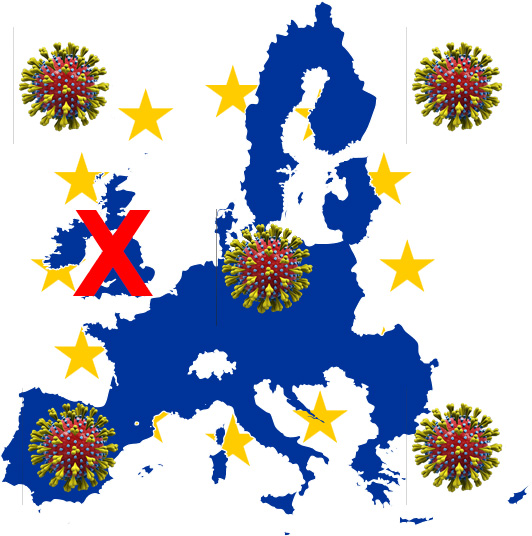 The LSE’s Centre for Economic Performance has just published a paper looking at the joint impact of Covid-19 and Brexit on the UK economy. Apart from the short-term shocks, both will have a long-term dampening effect on the UK economy. But they will largely affect different sectors.
The LSE’s Centre for Economic Performance has just published a paper looking at the joint impact of Covid-19 and Brexit on the UK economy. Apart from the short-term shocks, both will have a long-term dampening effect on the UK economy. But they will largely affect different sectors.
Covid-19 has affected, and will continue to affect, direct consumer-facing industries, such as shops, the hospitality and leisure industries, public transport and personal services. Brexit will tend to hit those industries most directly involved in trade with Europe, the UK’s biggest trading partner. These industries include manufacturing, financial services, posts and telecommunications, mining and quarrying, and agriculture and fishing.
Despite the fact that largely different sectors will be hit by these two events, the total effect may be greater than from each individually. One of the main reasons for this is the dampening impact of Covid-19 on globalisation. 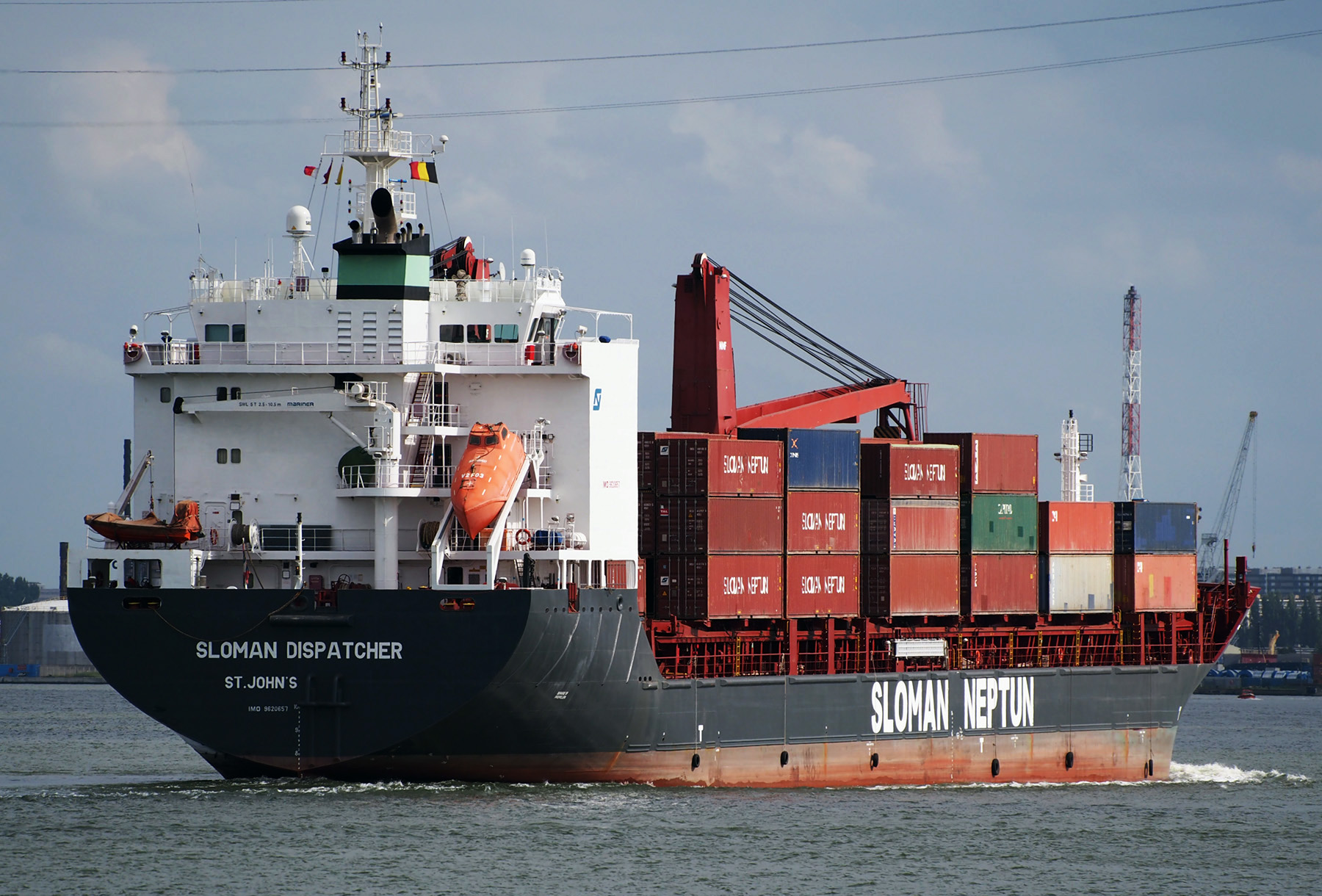 Travel restrictions are likely to remain tighter to more distant countries. And countries are likely to focus on trading within continents or regions rather than the whole world. For the UK, this, other things being equal, would mean an expansion of trade with the EU relative to the rest of the world. But, unless there is a comprehensive free-trade deal with the EU, the UK would not be set to take full advantage of this trend.
Travel restrictions are likely to remain tighter to more distant countries. And countries are likely to focus on trading within continents or regions rather than the whole world. For the UK, this, other things being equal, would mean an expansion of trade with the EU relative to the rest of the world. But, unless there is a comprehensive free-trade deal with the EU, the UK would not be set to take full advantage of this trend.
Another problem is that the effects of the Covid-19 pandemic have weakened the economy’s ability to cope with further shocks, such as those from Brexit. Depending on the nature (or absence) of a trade deal, Brexit will impose higher burdens on trading companies, including meeting divergent standards and higher administrative costs from greater form filling, inspections and customs delays.
Papers
Articles
Questions
- Referring to the LSE paper, give some examples of industries that are likely to be particularly hard hit by Brexit when the transition period ends? Explain why.
- Why have university finances been particularly badly affected by both Covid-19 and Brexit? Are there any other sectors that have suffered (or will suffer) badly from both events?
- Is there a scenario where globalisation in trade could start to grow again?
- Has Covid-19 affected countries’ comparative advantage in particular products traded with particular countries and, if so, how?
- The authors of the LSE report argue that ‘government policies to stimulate demand, support workers to remain in employment or find new employment, and to support businesses remain essential’. How realistic is it to expect the government to provide additional support to businesses and workers to deal with the shock of Brexit?
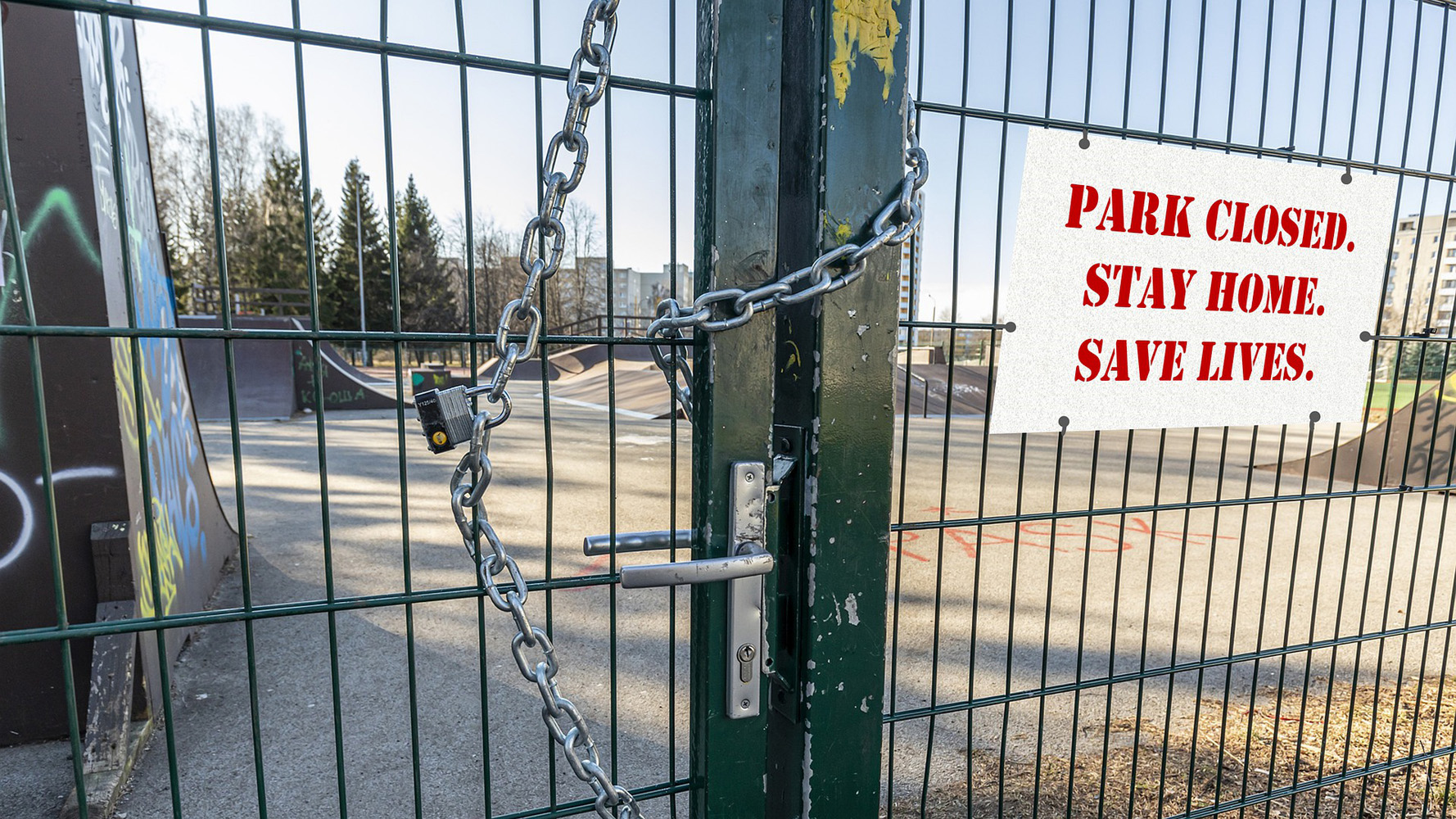 Three international agencies, the IMF, the European Commission and the OECD, all publish six-monthly forecasts for a range of countries. As each agency’s forecasts have been published this year, so the forecasts for economic growth and other macroeconomic indicators, such as unemployment, have got more dire.
Three international agencies, the IMF, the European Commission and the OECD, all publish six-monthly forecasts for a range of countries. As each agency’s forecasts have been published this year, so the forecasts for economic growth and other macroeconomic indicators, such as unemployment, have got more dire.
The IMF was the first to report. Its World Economic Outlook, published on 14 April, forecast that in the UK real GDP would fall by 6.5% in 2020 and rise by 4% in 2021 (not enough to restore GDP to 2019 levels); in the USA it would fall by 5.9% this year and rise by 4.7% next year; in the eurozone it would fall by 7.5% this year and rise by 4.7% next.
The European Commission was next to report. Its AMECO database was published on 6 May. This forecast that UK real GDP would fall by 8.3% this year and rise by 6% next; in the USA it would fall by 6.5% this year and rise by 4.9% next; in the eurozone it would fall by 7.7% this year and rise by 6.3% next.
The latest to report was the OECD on 10 June. The OECD Economic Outlook was the most gloomy. In fact, it produced two sets of forecasts.
The first, more optimistic one (but still more gloomy than the forecasts of the other two agencies) was based on the assumption that lockdowns would continue to be lifted and that there would be no second outbreak later in the year. This ‘single-hit scenario’ forecast that UK real GDP would fall by 11.5% this year and rise by 9% next (a similar picture to France and Italy); in the USA it would fall by 7.3% this year and rise by 4.1% next; in the eurozone it would fall by 9.1% this year and rise by 6.5% next.
The second set of OECD forecasts was based on the assumption that there would be a second wave of the virus and that lockdowns would have to be reinstated. Under this ‘double-hit scenario’, the UK’s GDP is forecast to fall by 14.0% this year and rise by 5.0 per cent next; in the USA it would fall by 8.5% this year and rise by 1.9% next; in the eurozone it would fall by 11.5% this year and rise by 3.5% next.
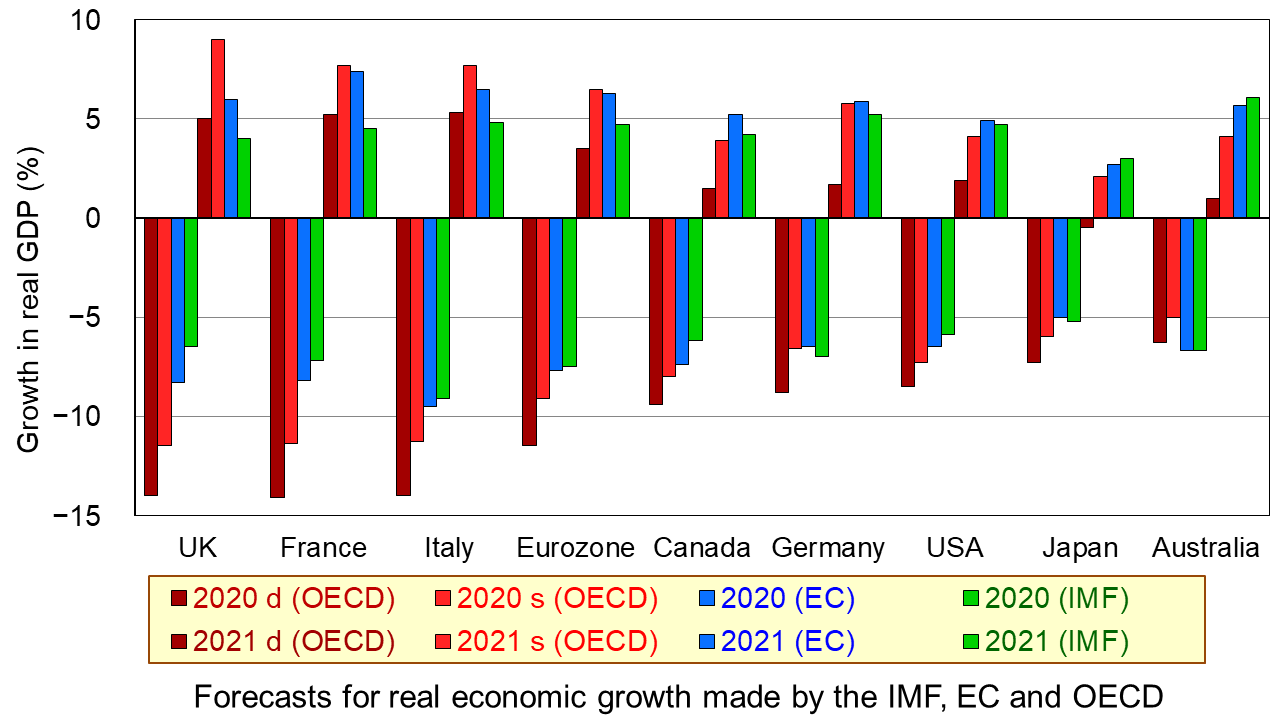
The first chart shows the four sets of forecasts (including two from the OECD) for a range of countries. The first four bars for each country are the forecasts for 2020; the other four bars for each country are for 2021. (Click here for a PowerPoint of the chart.)
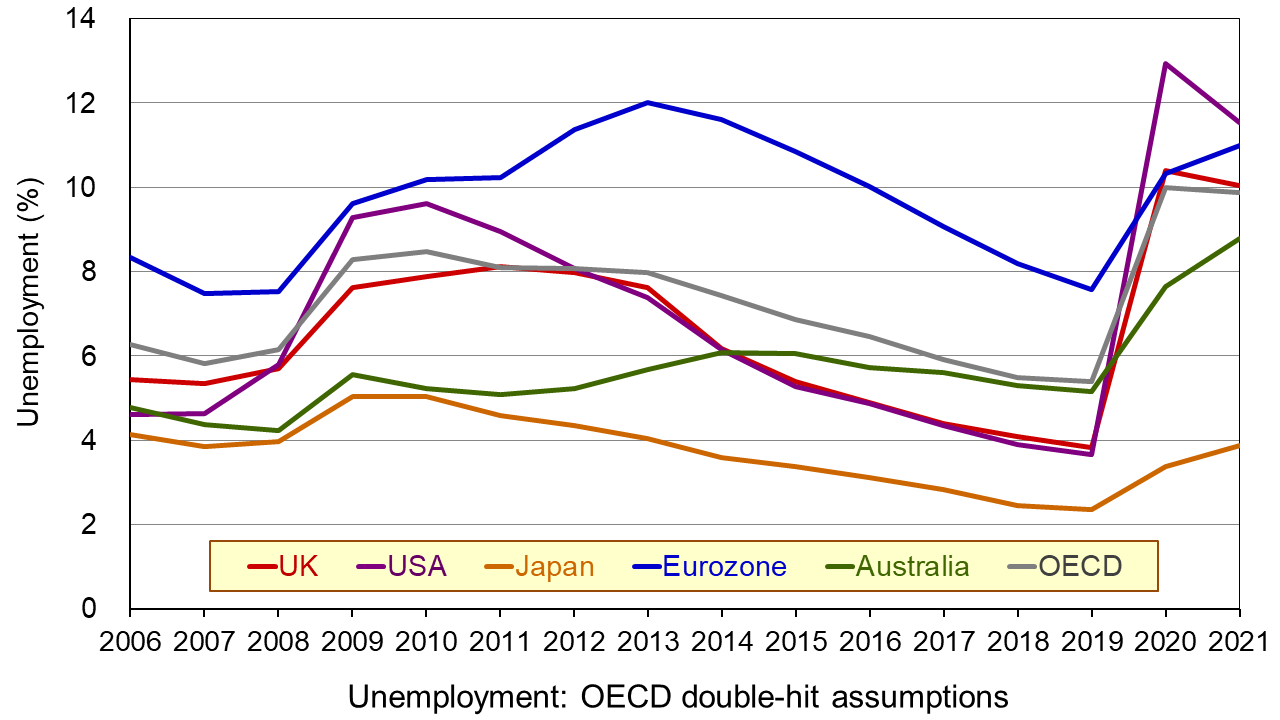
The second chart shows unemployment rates from 2006. The figures for 2020 and 2021 are OECD forecasts based on the double-hit assumption. You can clearly see the dramatic rise in unemployment in all the countries in 2020. In some cases it is forecast that there will be a further rise in 2021. (Click here for a PowerPoint of the chart.)
As the OECD states:
In both scenarios, the recovery, after an initial, rapid resumption of activity, will take a long time to bring output back to pre-pandemic levels, and the crisis will leave long-lasting scars – a fall in living standards, high unemployment and weak investment. Job losses in the most affected sectors, such as tourism, hospitality and entertainment, will particularly hit low-skilled, young, and informal workers.
But why have the forecasts got gloomier? There are both demand- and supply-side reasons.
Aggregate demand has fallen more dramatically than originally anticipated. Lockdowns have lasted longer in many countries than governments had initially thought, with partial lockdowns, which replace them, taking a long time to lift. With less opportunity for people to go out and spend, consumption has fallen and saving has risen. Businesses that have shut, some permanently, have laid off workers or they have been furloughed on reduced incomes. This too has reduced spending. Even when travel restrictions are lifted, many people are reluctant to take holidays at home and abroad and to use public transport for fear of catching the virus. This reluctance has been higher than originally anticipated. Again, spending is lower than before. Even when restaurants, bars and other public venues are reopened, most operate at less than full capacity to allow for social distancing. Uncertainty about the future has discouraged firms from investing, adding to the fall in demand.
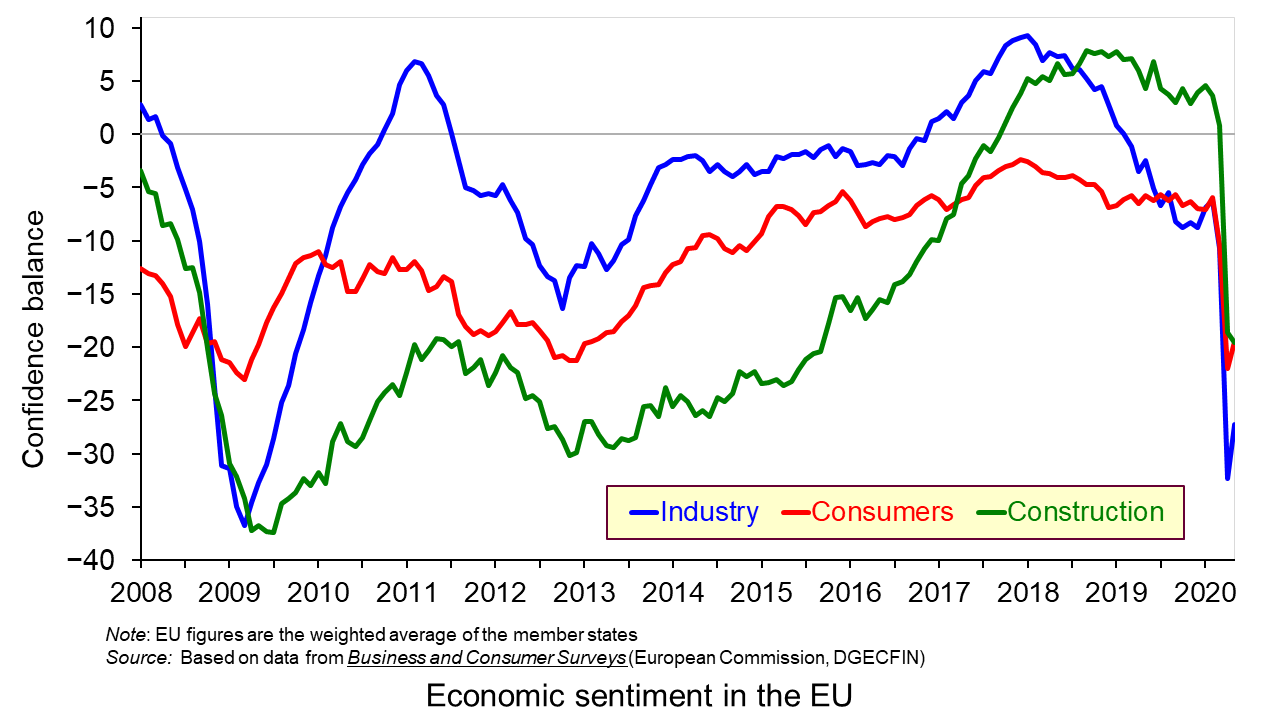
On the supply side, there has been considerable damage to capacity, with firms closing and both new and replacement investment being put on hold. Confidence in many sectors has plummeted as shown in the third chart which looks at business and consumer confidence in the EU. (Click here for a PowerPoint of the above chart.) Lack of confidence directly affects investment with both supply- and demand-side consequences.
Achieving a sustained recovery will require deft political and economic judgements by policymakers. What is more, people are increasingly calling for a different type of economy – one where growth is sustainable with less pollution and degradation of the environment and one where growth is more inclusive, where the benefits are shared more equally. As Angel Gurría, OECD Secretary-General, states in his speech launching the latest OECD Economic Outlook:
The aim should not be to go back to normal – normal was what got us where we are now.
Articles
OECD publications
Questions
- Why has the UK economy been particularly badly it by the Covid-19 pandemic?
- What will determine the size and timing of the ‘bounce back’?
- Why will the pandemic have “dire and long-lasting consequences for people, firms and governments”?
- Why have many people on low incomes faced harsher consequences than those on higher incomes?
- What are the likely environmental impacts of the pandemic and government measures to mitigate the effects?
 Pre-Covid 19, the climate change movement had gathered momentum with climate activist Greta Thunberg regularly in the news and people around the world striking in protest of inadequate government action on the climate crisis. However, now in a world overtaken by the pandemic, climate change is no longer at the centre and appears a more distant threat. The majority of the large climate change events due to take place this year have been delayed and policy announcements are aimed at supporting the current economic hardships. This is not surprising nor debatable, but there is a risk that, as Covid-19 dominates the news, policy and debates for a long time to come, this will overshadow any environmental initiatives that were due to be implemented.
Pre-Covid 19, the climate change movement had gathered momentum with climate activist Greta Thunberg regularly in the news and people around the world striking in protest of inadequate government action on the climate crisis. However, now in a world overtaken by the pandemic, climate change is no longer at the centre and appears a more distant threat. The majority of the large climate change events due to take place this year have been delayed and policy announcements are aimed at supporting the current economic hardships. This is not surprising nor debatable, but there is a risk that, as Covid-19 dominates the news, policy and debates for a long time to come, this will overshadow any environmental initiatives that were due to be implemented.
Governments around the globe are navigating their economies through the pandemic and starting to think about the future road to recovery. However, there is an argument that it doesn’t have to be a case of ‘either or’, as there is the potential for policies to address the Covid-19 crisis and climate change at the same time. How policy makers respond now could shape the fight against climate change for the future. One of the lessons from the pandemic is that quick responses to high impact risks are vital to reduce costs. With that in mind, and given the costs of climate change, it is arguable that now is the best time to address its challenges.
Climate change and Covid
 It is estimated that there was a total global loss of $3tn caused by natural disasters over the past decade. By 2050, cumulative damages from climate change are predicted to reach $8 trillion, impoverishing the world as a whole by 3% of GDP and the poorest regions by more. Climate activists argue that despite the economic consequences of climate change, the action taken by governments has been insufficient. In 2015, the then Bank of England governor, Mark Carney warned: ‘Once climate change becomes a defining issue for financial stability, it may already be too late.’
It is estimated that there was a total global loss of $3tn caused by natural disasters over the past decade. By 2050, cumulative damages from climate change are predicted to reach $8 trillion, impoverishing the world as a whole by 3% of GDP and the poorest regions by more. Climate activists argue that despite the economic consequences of climate change, the action taken by governments has been insufficient. In 2015, the then Bank of England governor, Mark Carney warned: ‘Once climate change becomes a defining issue for financial stability, it may already be too late.’
However, since the pandemic struck all over the world, there have been positive consequences for the environment. Pollution levels started dropping fast as airlines grounded fleets, car travel came to a stop and industries shut down. With 2.6bn people living under restrictions under their country’s lockdown, there has also been an impact on the environment, not just the spread of the virus. Given that the lockdowns across the world have come at huge social and human costs, is now not the time to ensure that these improvements for the environment are not just temporary but ignite long-term changes?
 Given the clear impacts and risks of Covid on peoples’ health, our ability to change our behaviour quickly has been striking. The importance of behaviour change has been brought to the centre and, arguably, it shows that we are capable of change when lives are at risk and are deemed more important than business-as-usual GDP growth. The application to climate change, however, is not as straightforward, as the costs to human lives are often viewed as a future problem.
Given the clear impacts and risks of Covid on peoples’ health, our ability to change our behaviour quickly has been striking. The importance of behaviour change has been brought to the centre and, arguably, it shows that we are capable of change when lives are at risk and are deemed more important than business-as-usual GDP growth. The application to climate change, however, is not as straightforward, as the costs to human lives are often viewed as a future problem.
Global cooperation
Dr Laure de Preux, Assistant Professor of Economics at Imperial College Business School, highlights the important role that cooperation across borders plays in the face of a global crisis like Coronavirus, and how that can be applied to the fight against climate change.
The big challenges the world is facing, including the climate change crisis, can only be dealt with efficiently through international cooperation. We cannot only act individually; the benefits of our actions are multiplied if integrated into a global strategy. In the case of COVID-19, social distancing measures can only be truly effective if they are adopted at a large scale.
World leaders are aware that their economies now face one of the most severe recessions in history as a consequence of the coronavirus restrictions. Governments are going to have to dedicate huge budgets to enable the economic activity to resume again. This presents a unique challenge, but also a massive opportunity for global cooperation. The question to be asked, therefore, is that if these stimulus packages are a one-off chance to transform the economy, how should the government spend it and what should be their focus? Should the recovery policies focus on creating a greener economy?
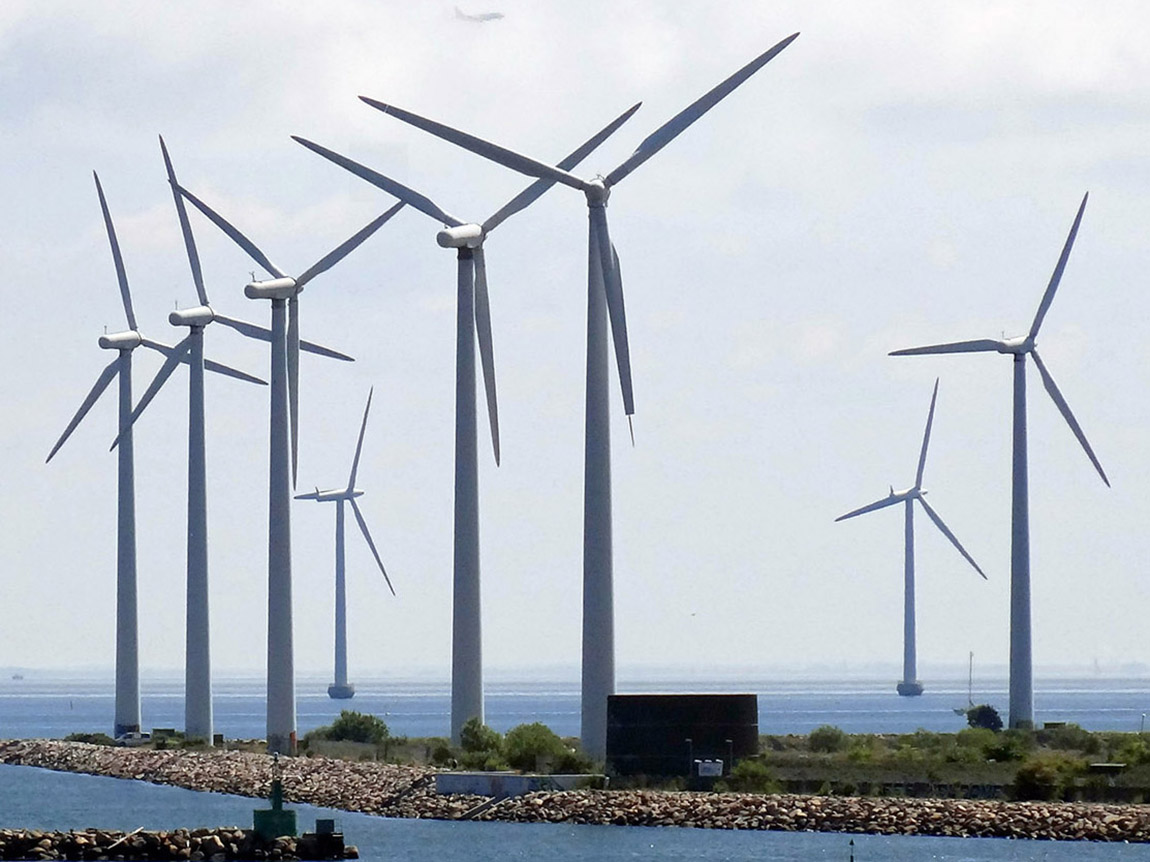 The European Union unveiled what it is calling the biggest ‘green’ stimulus package in history. Ursula von der Leyen, the European Commission president, told European Parliament members that this issue is about all nations and it is bigger than any one of them. The deputy Prime Minister of Spain, Teresa Ribera, states that there is a greater risk by not acting in this way. She argues that if the recovery is not green, then it will be nothing but a short-cut to solve the current problems rather than a true economic recovery.
The European Union unveiled what it is calling the biggest ‘green’ stimulus package in history. Ursula von der Leyen, the European Commission president, told European Parliament members that this issue is about all nations and it is bigger than any one of them. The deputy Prime Minister of Spain, Teresa Ribera, states that there is a greater risk by not acting in this way. She argues that if the recovery is not green, then it will be nothing but a short-cut to solve the current problems rather than a true economic recovery.
It is not just in Europe where the recovery has an environment focus. Joe Biden is believed to be planning a similarly huge green stimulus package for the US. The model echoes the vast investment projects of the New Deal that helped lift America out of the Great Depression in the 1930s.
There are sound economic reasons why politicians see green technology as a prudent investment. Renewable energy is now often cheaper than fossil fuels in large parts of the world and the technologies are proven and can be built at scale today. The argument for renewables providing a pathway for clean future growth is based on the logic of much of manufacturing – the more you produce, the cheaper it gets. However, China does not appear to have similar plans for their recovery. China produces almost a third of the world’s emissions, as much as the USA and the EU combined. At the annual National People’s Congress, there was no indication that the big expansion of coal-fired electricity generation would be reversed, even though it is also expanding the production of renewable energy. China expanded its coal-fired power stations as a key part of its stimulus package after the 2008 financial crisis.
Policy decisions
 The UK government receives ongoing pressure from energy companies. The boss of energy giant SSE, Alistair Phillips-Davies has warned that a failure to deal with climate change could eventually have a greater economic impact than coronavirus. SSE wants the UK government to encourage private investment in renewables by giving the green light to big new projects, such as hydrogen and carbon capture plants and boosting electric vehicles. Despite the impacts of climate change not being immediately felt in comparison to Covid-19, Phillips-Davies argues that a failure to deal with climate change could lead to great long-term impacts:
The UK government receives ongoing pressure from energy companies. The boss of energy giant SSE, Alistair Phillips-Davies has warned that a failure to deal with climate change could eventually have a greater economic impact than coronavirus. SSE wants the UK government to encourage private investment in renewables by giving the green light to big new projects, such as hydrogen and carbon capture plants and boosting electric vehicles. Despite the impacts of climate change not being immediately felt in comparison to Covid-19, Phillips-Davies argues that a failure to deal with climate change could lead to great long-term impacts:
While it is still too early to predict with confidence the full human, social and economic impact of coronavirus, we can say with certainty that significant investment will be needed to rebuild the UK economy in its wake.
It is clear that any pandemic-induced financial decisions made over the next 12 months will shape the global economy for the next decade. The full impact of the virus on climate change will be determined by the world’s stimulus measures adopted post-pandemic. Following the 2008 financial crisis, the energy-intensive stimulus measures that followed, particularly in China, boosted emissions. Therefore, if we are to meet the reduction in emissions target our response needs to be green, helping to shape a sustainable future. Dr Alex Koberle, of the Grantham Institute at Imperial College London, argues that Governments should take time to reflect, learn from past mistakes and redirect development towards a sustainable future.
Shouldn’t growth be given priority?
With 1.6 billion people working in the informal economy worldwide reckoned to be in immediate danger of losing their livelihoods (according to the International Labour Organization), is now the right time to be focusing on the climate? Industries such as airlines and car manufacturing are strategic industries, employing millions of people. Headlines of longer-term environmental targets will be given less importance than headlines of job losses. Recovery relies on the government finding ways to employ lots and lots of people. There is a close relationship between real GDP, employment and energy consumption. Therefore, any policies aimed at reducing greenhouse gas emissions, unless carefully directed, could reduce economic growth and employment for both less and more developed economies. Such policies would increase the cost of conventional energy sharply.
Critics of a green energy policy for recovery argue that investing in renewable energy ignores the adverse effects of reduced investment and higher energy costs in other sectors. By governments prioritising policy to focus on the environment, they could harm the ability of most people to improve their own circumstances, especially given the terrible economic shock caused by the lockdowns.
Conclusion
 With the majority of news in recent months providing little joy, there has been at least the positive impact on the environment. However, advocates say it not a cause for celebration and warn that any benefits are likely to be short lived. There have been some positive behavioural impacts but the true test will be what happens in the recovery phase. If the focus is returned to business as usual what happens to the targets actioned prior to Covid-19?
With the majority of news in recent months providing little joy, there has been at least the positive impact on the environment. However, advocates say it not a cause for celebration and warn that any benefits are likely to be short lived. There have been some positive behavioural impacts but the true test will be what happens in the recovery phase. If the focus is returned to business as usual what happens to the targets actioned prior to Covid-19?
The immediate priority of all governments right now is to control the pandemic and to save lives. As their policy interventions have an impact and economies start to emerge from this crisis, then there is an important debate to be had about how new investments can help create a cleaner, greener recovery. We have learnt from the current pandemic that changes can be made when consequences are imminent, however, climate change is a threat that doesn’t go away, and is arguably just as urgent. Solutions to both crises can be integrated into a coherent response to propel the global economy towards sustainable growth and increased resilience.
Articles
Letter
Questions
- Are government attempts to reduce the impact of climate change beneficial or harmful to UK firms?
- What policy instruments can the government use to increase economic activity?
- How does an increase in investment affect aggregate demand?
- What are the costs and benefits of economic growth?
- Why can climate change be described as a market failure?
 To make a sensible comparison of one year’s national income generated from the production of goods and services with another we need to take inflation into account. Changes in inflation-adjusted GDP represent changes in the volume of production of a country’s goods and services: in other words, the real value of goods and services. We revisit the blog written back in April 2019, prior the pandemic, to show how changes in real GDP evidence what we may refer to as the twin characteristics of economic growth: positive long-term growth but with fluctuating short-term rates of growth.
To make a sensible comparison of one year’s national income generated from the production of goods and services with another we need to take inflation into account. Changes in inflation-adjusted GDP represent changes in the volume of production of a country’s goods and services: in other words, the real value of goods and services. We revisit the blog written back in April 2019, prior the pandemic, to show how changes in real GDP evidence what we may refer to as the twin characteristics of economic growth: positive long-term growth but with fluctuating short-term rates of growth. Chart 1 shows current-price estimates of GDP from 1950 when the value of GDP was estimated at £12.7 billion. The increase to £2.156 trillion in 2020 amounts to a proportionate increase of almost 170 times, a figure that rises to 211 times if we compare the 1950 value with the latest IMF estimate for 2025 of £2.689 trillion. However, if we want to make a more meaningful comparison of the country’s national income by looking at the longer-term increase in the volume of production, we need to adjust for inflation. (Click here to download a PowerPoint copy of the chart.)
Chart 1 shows current-price estimates of GDP from 1950 when the value of GDP was estimated at £12.7 billion. The increase to £2.156 trillion in 2020 amounts to a proportionate increase of almost 170 times, a figure that rises to 211 times if we compare the 1950 value with the latest IMF estimate for 2025 of £2.689 trillion. However, if we want to make a more meaningful comparison of the country’s national income by looking at the longer-term increase in the volume of production, we need to adjust for inflation. (Click here to download a PowerPoint copy of the chart.) Chart 2 shows the annual rate of growth in real GDP each year since 1950. From it, we see the inherent instability that is a key characteristic of the macroeconomic environment. This instability is, of course, mirrored in the output path of real GDP in Chart 1, but the annual rates of growth show the instability more clearly. We can readily see the impact on national output of the global financial crisis and the global health emergency.
Chart 2 shows the annual rate of growth in real GDP each year since 1950. From it, we see the inherent instability that is a key characteristic of the macroeconomic environment. This instability is, of course, mirrored in the output path of real GDP in Chart 1, but the annual rates of growth show the instability more clearly. We can readily see the impact on national output of the global financial crisis and the global health emergency. The twin characteristics of growth can be seen simultaneously by combining the output path captured by the levels of real GDP with the annual rates of growth. This is shown in Chart 3. The longer-term growth seen in the economy’s output path is generally argued to be driven by the quantity and quality of the economy’s resources, and their effectiveness when combined in production. In other words, it is the supply-side that determines the trajectory of the output path over the longer term. (Click here to download a PowerPoint copy of the chart.)
The twin characteristics of growth can be seen simultaneously by combining the output path captured by the levels of real GDP with the annual rates of growth. This is shown in Chart 3. The longer-term growth seen in the economy’s output path is generally argued to be driven by the quantity and quality of the economy’s resources, and their effectiveness when combined in production. In other words, it is the supply-side that determines the trajectory of the output path over the longer term. (Click here to download a PowerPoint copy of the chart.) Back in June,
Back in June,  In essence the picture is similar to that painted in April. The IMF predicts a large-scale fall in GDP and rise in unemployment, government borrowing and government debt for 2020 (compared with 2019) across virtually all countries.
In essence the picture is similar to that painted in April. The IMF predicts a large-scale fall in GDP and rise in unemployment, government borrowing and government debt for 2020 (compared with 2019) across virtually all countries.  There will then be somewhat of a ‘bounce back’ in GDP in 2021, but not to the levels of 2019. World real GDP is predicted to rise by 5.2% in 2021. (Click
There will then be somewhat of a ‘bounce back’ in GDP in 2021, but not to the levels of 2019. World real GDP is predicted to rise by 5.2% in 2021. (Click  Inflation is set to fall from already low levels. Several countries are expected to see falling prices.
Inflation is set to fall from already low levels. Several countries are expected to see falling prices.  Government debt will consequently rise more rapidly. Deficits are predicted to fall in 2021 as economies recover and hence the rise in debt will slow down or in some cases, such as Germany, even fall. (Click
Government debt will consequently rise more rapidly. Deficits are predicted to fall in 2021 as economies recover and hence the rise in debt will slow down or in some cases, such as Germany, even fall. (Click  In the short term, the greatest uncertainty concerns the extent of the second wave, the measures put in place to contain the spread of the virus and the compensation provided by governments to businesses and workers. The WEO report was prepared when the second wave was only just beginning. It could well be that countries will experience a deeper recession in 2000 and into 2021 than predicted by the IMF.
In the short term, the greatest uncertainty concerns the extent of the second wave, the measures put in place to contain the spread of the virus and the compensation provided by governments to businesses and workers. The WEO report was prepared when the second wave was only just beginning. It could well be that countries will experience a deeper recession in 2000 and into 2021 than predicted by the IMF. One of the greatest uncertainties in the medium term concerns the stance of fiscal and monetary policies. Will governments continue to run large deficits to support demand or will they attempt to reduce deficits by raising taxes and/or reducing benefits and/or cutting government current or capital expenditure?
One of the greatest uncertainties in the medium term concerns the stance of fiscal and monetary policies. Will governments continue to run large deficits to support demand or will they attempt to reduce deficits by raising taxes and/or reducing benefits and/or cutting government current or capital expenditure? 
 The LSE’s Centre for Economic Performance has just
The LSE’s Centre for Economic Performance has just  Travel restrictions are likely to remain tighter to more distant countries. And countries are likely to focus on trading within continents or regions rather than the whole world. For the UK, this, other things being equal, would mean an expansion of trade with the EU relative to the rest of the world. But, unless there is a comprehensive free-trade deal with the EU, the UK would not be set to take full advantage of this trend.
Travel restrictions are likely to remain tighter to more distant countries. And countries are likely to focus on trading within continents or regions rather than the whole world. For the UK, this, other things being equal, would mean an expansion of trade with the EU relative to the rest of the world. But, unless there is a comprehensive free-trade deal with the EU, the UK would not be set to take full advantage of this trend. Three international agencies, the IMF, the European Commission and the OECD, all publish six-monthly forecasts for a range of countries. As each agency’s forecasts have been published this year, so the forecasts for economic growth and other macroeconomic indicators, such as unemployment, have got more dire.
Three international agencies, the IMF, the European Commission and the OECD, all publish six-monthly forecasts for a range of countries. As each agency’s forecasts have been published this year, so the forecasts for economic growth and other macroeconomic indicators, such as unemployment, have got more dire. 


 Pre-Covid 19, the climate change movement had gathered momentum with climate activist Greta Thunberg regularly in the news and people around the world striking in protest of inadequate government action on the climate crisis. However, now in a world overtaken by the pandemic, climate change is no longer at the centre and appears a more distant threat. The majority of the large climate change events due to take place this year have been delayed and policy announcements are aimed at supporting the current economic hardships. This is not surprising nor debatable, but there is a risk that, as Covid-19 dominates the news, policy and debates for a long time to come, this will overshadow any environmental initiatives that were due to be implemented.
Pre-Covid 19, the climate change movement had gathered momentum with climate activist Greta Thunberg regularly in the news and people around the world striking in protest of inadequate government action on the climate crisis. However, now in a world overtaken by the pandemic, climate change is no longer at the centre and appears a more distant threat. The majority of the large climate change events due to take place this year have been delayed and policy announcements are aimed at supporting the current economic hardships. This is not surprising nor debatable, but there is a risk that, as Covid-19 dominates the news, policy and debates for a long time to come, this will overshadow any environmental initiatives that were due to be implemented. It is estimated that there was a total global loss of $3tn caused by natural disasters over the past decade. By 2050, cumulative damages from climate change are predicted to reach $8 trillion, impoverishing the world as a whole by 3% of GDP and the poorest regions by more. Climate activists argue that despite the economic consequences of climate change, the action taken by governments has been insufficient. In 2015, the then Bank of England governor, Mark Carney warned: ‘Once climate change becomes a defining issue for financial stability, it may already be too late.’
It is estimated that there was a total global loss of $3tn caused by natural disasters over the past decade. By 2050, cumulative damages from climate change are predicted to reach $8 trillion, impoverishing the world as a whole by 3% of GDP and the poorest regions by more. Climate activists argue that despite the economic consequences of climate change, the action taken by governments has been insufficient. In 2015, the then Bank of England governor, Mark Carney warned: ‘Once climate change becomes a defining issue for financial stability, it may already be too late.’  The European Union unveiled what it is calling the biggest ‘green’ stimulus package in history. Ursula von der Leyen, the European Commission president, told European Parliament members that this issue is about all nations and it is bigger than any one of them. The deputy Prime Minister of Spain, Teresa Ribera, states that there is a greater risk by not acting in this way. She argues that if the recovery is not green, then it will be nothing but a short-cut to solve the current problems rather than a true economic recovery.
The European Union unveiled what it is calling the biggest ‘green’ stimulus package in history. Ursula von der Leyen, the European Commission president, told European Parliament members that this issue is about all nations and it is bigger than any one of them. The deputy Prime Minister of Spain, Teresa Ribera, states that there is a greater risk by not acting in this way. She argues that if the recovery is not green, then it will be nothing but a short-cut to solve the current problems rather than a true economic recovery.  The UK government receives ongoing pressure from energy companies. The boss of energy giant SSE, Alistair Phillips-Davies has warned that a failure to deal with climate change could eventually have a greater economic impact than coronavirus. SSE wants the UK government to encourage private investment in renewables by giving the green light to big new projects, such as hydrogen and carbon capture plants and boosting electric vehicles. Despite the impacts of climate change not being immediately felt in comparison to Covid-19, Phillips-Davies argues that a failure to deal with climate change could lead to great long-term impacts:
The UK government receives ongoing pressure from energy companies. The boss of energy giant SSE, Alistair Phillips-Davies has warned that a failure to deal with climate change could eventually have a greater economic impact than coronavirus. SSE wants the UK government to encourage private investment in renewables by giving the green light to big new projects, such as hydrogen and carbon capture plants and boosting electric vehicles. Despite the impacts of climate change not being immediately felt in comparison to Covid-19, Phillips-Davies argues that a failure to deal with climate change could lead to great long-term impacts:  With the majority of news in recent months providing little joy, there has been at least the positive impact on the environment. However, advocates say it not a cause for celebration and warn that any benefits are likely to be short lived. There have been some positive behavioural impacts but the true test will be what happens in the recovery phase. If the focus is returned to business as usual what happens to the targets actioned prior to Covid-19?
With the majority of news in recent months providing little joy, there has been at least the positive impact on the environment. However, advocates say it not a cause for celebration and warn that any benefits are likely to be short lived. There have been some positive behavioural impacts but the true test will be what happens in the recovery phase. If the focus is returned to business as usual what happens to the targets actioned prior to Covid-19?